Dear Capitoli,
Happy Election Day. The first eight Capitolisms are in the bag, and it’s been pretty—ahem—intense so far. We’ve grumbled about the CDC eviction moratorium, “libertarian economics,” tariffs, wages, Trump and Biden economic policies, and Section 230. There have been a lot of charts. A lot. Given that workload, and the fact that there’s not really any policy being made right now (and we could all use a little distraction awaiting election returns), I figured it’s time for a brain break to cover something both near and dear to my heart and vitally important: nachos.
However, before we begin, a quick word about my Dispatch colleague, David French. Thursday night, David published a column about emotion and politics. The piece itself was fine, I guess. But it was troubling to see David once again resort to division and acrimony by attacking me and the entire Capitolism family in the newsletter’s title (and conclusion):

I say “once again,” because this is not the first time that David has resorted to anti-chartism to sell clicks. See, for example, his September 20 column which took not one but two gratuitous swipes at the art form. I let that one slide (and this earlier one), but French’s latest attack is just too much. It’s especially frustrating because when David isn’t out there attacking charts, he’s using them—even in the very same columns. In fact, I count at least 11 times that French has positively used charts to make his point. That’s telling, wouldn’t you say? Anyway, it’s all just too much so I’ve created a chart of my own based on an objective meta-analysis of the aforementioned columns:
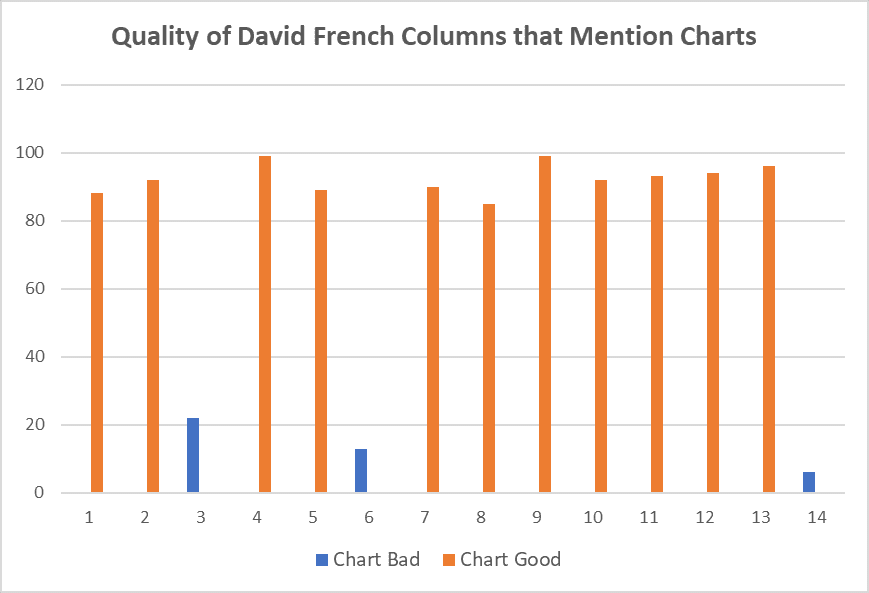
My culture is not your rhetorical device, David French.
Now back to the nachos.
For those not on Twitter or fans of The Remnant, I have some views on the subject. They are mostly in good fun. Mostly. Put simply, I’m a firm believer that many of the “nachos” you see in sports bars, ballparks, and on seedy websites aren’t really nachos at all and shouldn’t be treated as such. They’re what I call “notchos.” They’re also far inferior to real, actual nachos, in terms of history, efficiency, and—most of all—taste.
Allow me to explain.
But before I do, however, let’s first provide a simple and definitive taxonomy:
Nachos
Also (erroneously) called “Texas Nachos,” these are canon and have three main parts:
1) The Essential Core of a flat(ish) layer of chips, melted/shredded cheese (cheddar and/or a cheddar-jack mix), and pickled jalapeño;
2) The Usual Addition of refried beans (beneath the cheese) and grilled or shredded meat (usually lightly-seasoned/marinated beef, pork and/or chicken); and
3) A side of the Tex-Mex Triumvirate: sour cream, guacamole, and pico de gallo.
Of course, some variation here is perfectly acceptable: Maybe you want a black bean base or grilled shrimp on top or roasted corn salsa on the side. Maybe you don’t want beans or meat at all. All fine, as long as the standard single-chip/shredded cheese (not queso) base is there, and the accoutrements are all firmly in the Tex-Mex Family (i.e., no freaking chili, you monsters). Here’s a fine example:
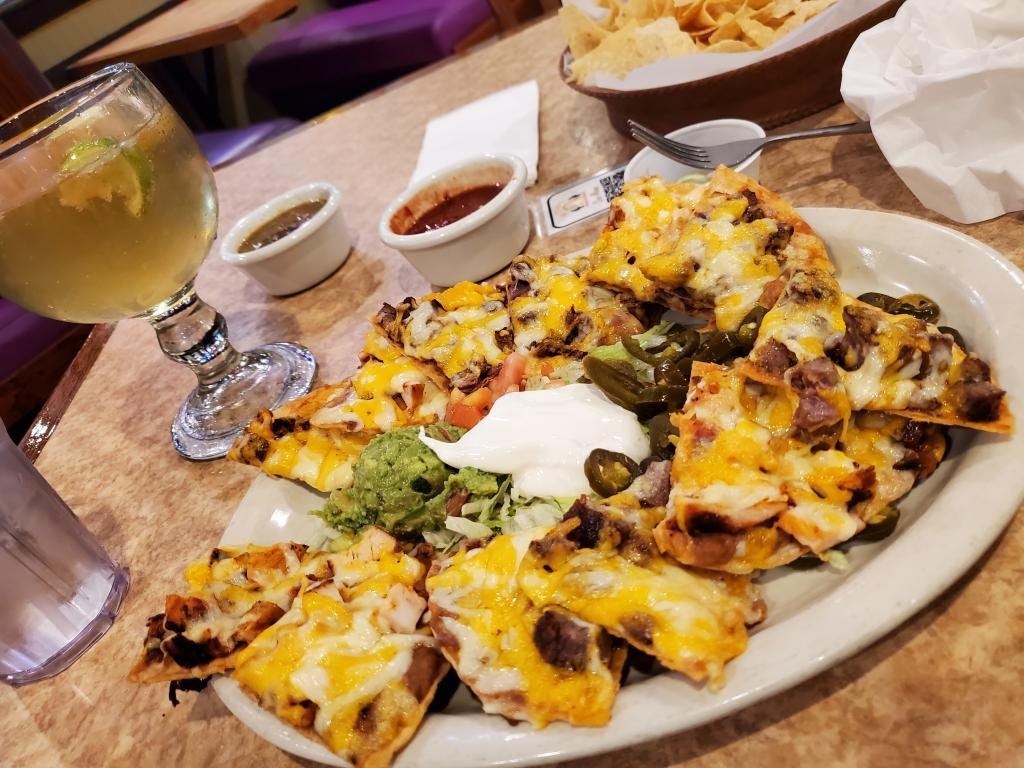
(The beer/lime is optional but highly recommended.)
Notchos
There are three main types of fake nachos:
-
Ballpark Nachos. Contrary to some vicious internet rumors, Ballpark Nachos—which first debuted at my childhood cathedral Arlington Stadium (go Rangers!) in 1976 and are today the corn chip and pumpable-cheese-sauce/jalapeño mess you get at any decent sports venue in America—are also canon (and quite tasty). They’re just not nachos. They’re Ballpark Nachos. And that’s fine.
-
Bar Nachos. This is where things begin to fall off the rails. “Bar Nachos” are simply messy piles of corn chips hastily smothered in lord-knows-what—sometimes resembling nacho ingredients but often not (barbecue sauce? what the &$@*, man?)—and served to the unwitting American masses, usually with a game on in the background and some junky domestic macrobrew on the side. These often involve chili or queso. Sometimes Guy Fieri and a trash can are present. Sometimes it’s a Wisconsin (or whatever) family desperate to go viral. Regardless of the setting or server, however, these are an abomination.
-
Bizarre Things Also Called Nachos: In this most-offensive-and-bizarre catchall category, “nachos” are basically any bread-like substance smothered with a liquid substance. Herein, you find ridiculous things like Hummus Nachos, or Olive Garden Italian Nachos, or my personal favorite, Candy Corn Nachos:
Terrifying and Wrong.
So now that we’ve established the categories and my obvious (unimpeachable) preferences, let’s analyze each pursuant to three objective and highly-scientific factors:
1) Historical and Definitional Accuracy
Probably the best and most definitive look at the nacho’s history and etymology comes (unsurprisingly) from the Smithsonian and an Oxford English Dictionary researcher, Adrianna Orr, tasked in the 1980s with determining the word’s origin:
Using this information, Orr tracked down a quote from the elusive 1954 St Anne’s Cookbook printed by The Church of the Redeemer, Eagle Pass, Texas, which includes a recipe for a dish called “Nachos Especiales.”
What Orr would find is that, in 1943 in Piedras Negras, Mexico — just across the border from Eagle Pass, a group of hungry army wives were the first to eat the meal. When the ladies went to a restaurant called the Victory Club, the maitre d’, Ignacio “Nacho” Anaya greeted them. Without a chef around, Anaya threw together whatever food he could find in the kitchen that “consisted of near canapes of tortilla chips, cheese, and jalapeno peppers.” The cheese of choice was reportedly Wisconsin cheddar. Anaya named the dish Nachos Especiales and it caught on—on both sides of the border—and the original title was shortened to “nachos.”
The original St. Anne’s Cookbook recipe is as follows:
Cut a stack of corn tortillas into 4 wedges. Fry them in about an inch of vegetable oil till crisp. Place on a baking sheet and top liberally with longhorn cheddar cheese and jalapeño pepper slices. Bake at 400 degrees till melted and bubbling. Serve with salsa and sour cream if desired.”
The New York Times’ recent look at nachos—great on history but unsurprisingly too liberal on permissible modern recipes—adds some delightful color on the nacho’s globalist, borderless origins:
Colby [cheese] was widely used in the region during World War II, when nachos were created, said Dr. Adalberto Peña de los Santos, the director of the International Nacho Festival, which is usually held in October on the banks of the Rio Grande. It was a time of hardship on both sides of the border.
“In Piedras, we used to call Colby ‘queso relief,’” he said. “It was one of the ingredients provided by the U.S. government.” People who received the cheese on the American side of the border would share, sell or barter with relatives on the Mexican side.
Dr. Peña de los Santos said it was fitting that the signature dish from the region includes an American cheese and was first eaten by Americans: It shows how fluid the food and culture of the region are, routinely blurring the border.
“When the geopolitical border came, it divided the community and the families, but not in every way,” Mr. Medrano said. “We have been living and eating this shared and coherent culinary reality for thousands of years.”
No wonder I love them.
Anyway, other historians note that while Anaya invented the nacho, it was Carmen Rocha, a waitress at El Cholo Mexican restaurant in Los Angeles, who “is credited for making Nachos popular” in the 1950s, having even served them to big fan Jack Nicholson. El Cholo still sells Carmen’s Nachos, which you can see on their Instagram page (in excellent form):
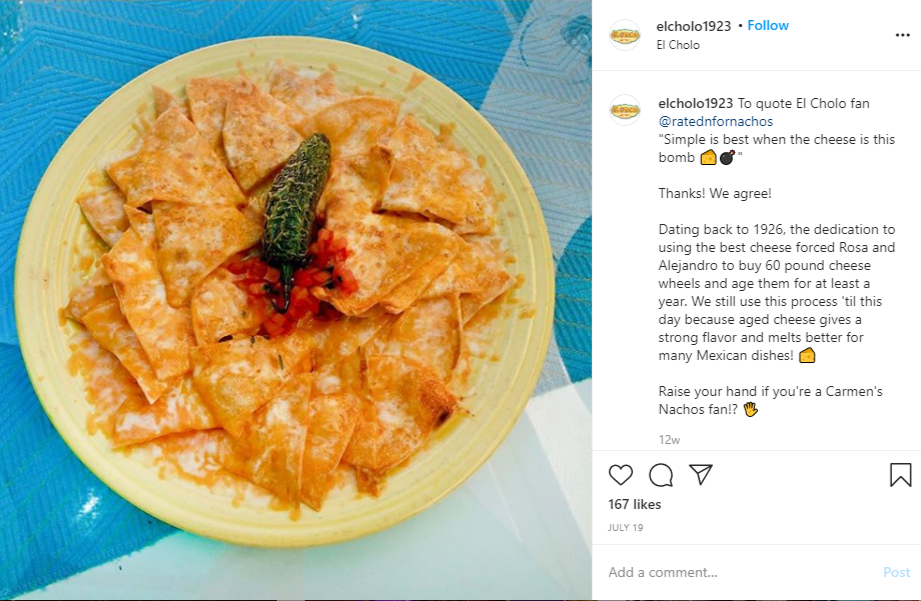
All of this history feeds into the OED’s formal definition of nacho, which is provided below and establishes not only the Essential Core (tortilla chip and melted cheese), but also its geographic and historical origins:
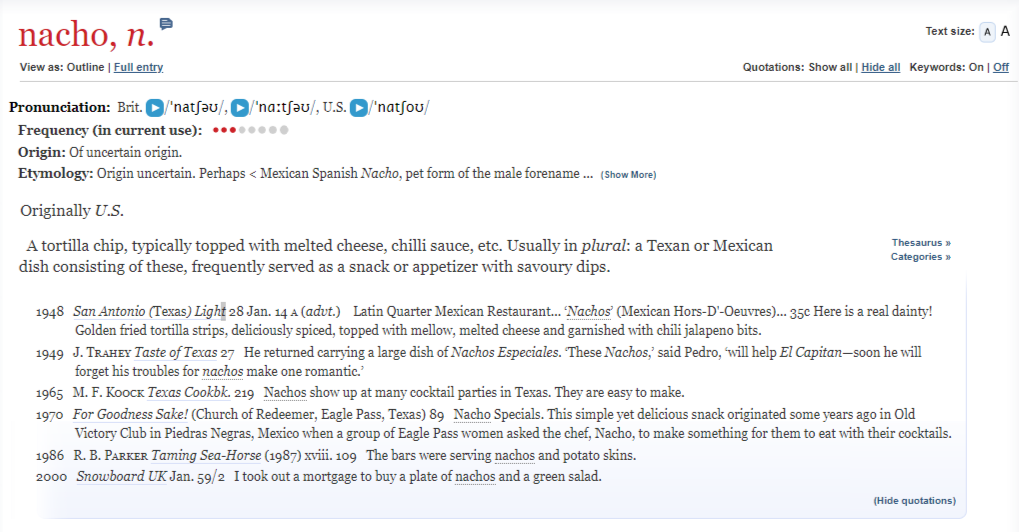
As the definition above also shows (see the 1986 entry), it was not until the mid-1980s that Bar Nachos arrived and began corrupting the discourse. Thus, those who today claim that Bar Nachos are “nachos” are essentially the equivalent of people who say that “literally” now means “figuratively.” In other words, Bad People.
So, both history and the dictionary establish that a “nacho,” properly defined, entails (1) a flat sheet of tortilla chips; and (2) shredded/melted cheese (i.e., the Essential Core). The New York Times also helpfully notes that, as per the official International Nacho Festival rules, “some kind of chile” (usually pickled jalapeños) is also required. Any “nachos” that lack these three essentials are simply impostors.
2) Efficiency
There is a bizarre myth that nacho preparation is too time- and labor-intensive, but this view suffers from three fatal flaws:
-
First, it falsely assumes a process that is as sloppy and uncivilized as Bar Nachos themselves, ignoring that any legitimate chef can and will create a simple assembly line for speedy (and consistent) nacho production.
-
Second, and relatedly, it assumes that per-chip construction time remains constant over the entire batch, when in reality one’s speed and efficiency will increase substantially—perhaps even exponentially—as the learning curve is surmounted and economies of scale are achieved via the aforementioned assembly line. This is basic science.
-
Third, and perhaps most importantly, it irrationally ignores how per-chip construction dramatically improves efficiency of consumption—the essential second element of any nacho meal. Indeed, focusing only on preparation and ignoring consumption is akin to bragging you have a 30-minute commute to the office by counting only the early morning (traffic-less) in-bound part of the trip. Foolish! On the consumption side, nachos dominate the notcho competition: No time is wasted choosing chips’ actual toppings (or fishing around for said toppings) or working through numerous napkins due to the dish’s sloppy/soggy makeup. Instead, armed with a little more than a teaspoon in one hand and the nacho in the other, all of your consumption time is devoted to simply smashing those suckers into your grill (with the occasional pause for libations). It’s beautiful, really.
3) Taste/Experience
Finally, it’s simply an incontrovertible truth that true nachos are vastly superior to any other form of so-called “nacho,” in terms of both taste and experience. Every chip not only contains the perfect balance of all toppings, but also is a simple delight to eat, especially if you use the proper two-handed form noted above. By contrast, notchos—especially Bar Nachos—are a messy grab bag of chip and topping. Maybe, if you’re lucky, you get a few perfect chips per batch, but it’s most often (1) a bare chip with maybe a shred of cheese; or (2) a soggy pile of masa flour and slop. Of course, when you’re at the ballpark watching America’s game, this type of thing is acceptable. Anywhere else? A costly travesty.
Summing It All Up
An objective calculation of the three decisive factors above, using a standard 100-point scale for each factor, reveals the following, definitive assessment of the Nacho Taxonomy:
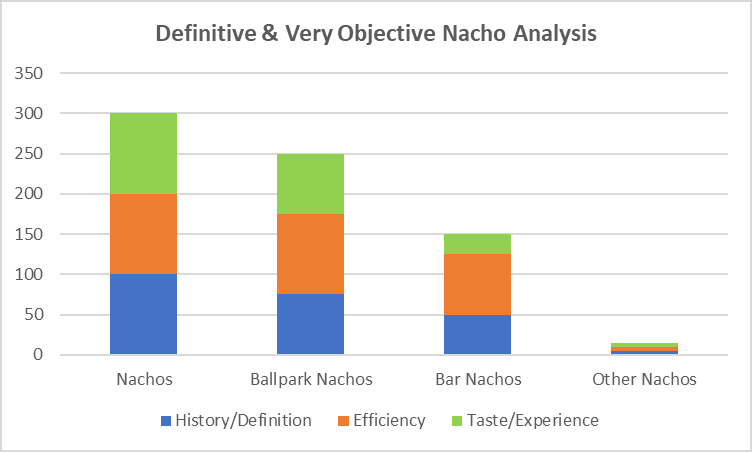
In my opinion, the model is actually too kind to the notchos—apparently it’s a baseball fan (and who can blame it). Regardless, the scientific outcome here is clear: There is only one real nacho, and all others are inferior—some by margins so large that they should be removed from the table (get it?) entirely.
Beyond the science, however, is perhaps a more important consideration: a nacho is a blessed union between one chip and one set of toppings—a union that has manifestly benefited humanity for generations. Anything else—i.e., the “notchos” above—corrupts that union, eventually diluting it to the point of meaninglessness. We see this everyday—see, for example, this terrible BuzzFeed poll, which allows for Cool Ranch Dorito chips, cream cheese, and—gasp—broccoli toppings. I don’t know about you, but an America with cool-ranch-cream-cheese-broccoli “nachos” is not an America in which I want to live, and I’d hope—nay, pray—that you agree.
Chart(s) of the Week
Two charts to keep in mind on Election Day:
*Big state population changes, 2000-2040 (projected) (source):

*The 2020 electorate (source):

P.S. I tried to find another chart, showing the change in eligible voters in the major “Sun Belt” battlegrounds between 2016 and 2020(p), but it doesn’t seem to exist. If you know of one, please send it my way.
The Links
Me on “America First” and Policy Nostalgia
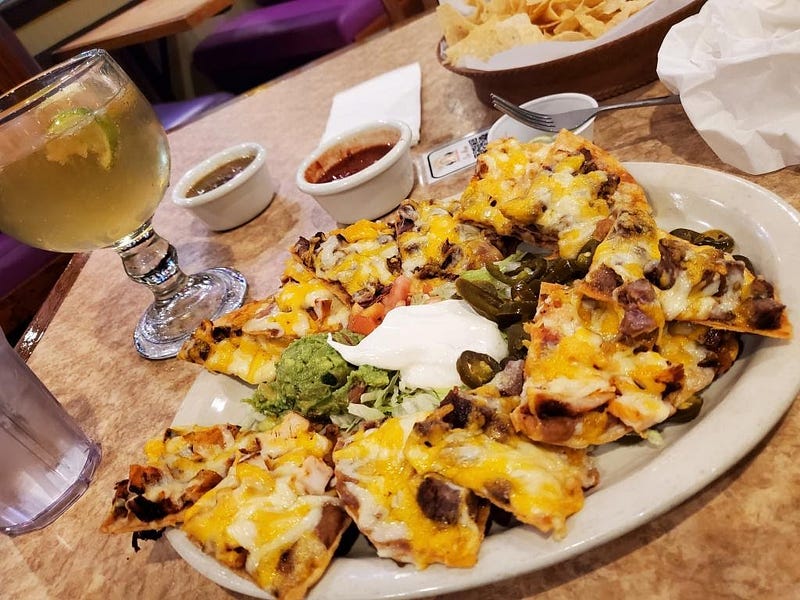











Please note that we at The Dispatch hold ourselves, our work, and our commenters to a higher standard than other places on the internet. We welcome comments that foster genuine debate or discussion—including comments critical of us or our work—but responses that include ad hominem attacks on fellow Dispatch members or are intended to stoke fear and anger may be moderated.